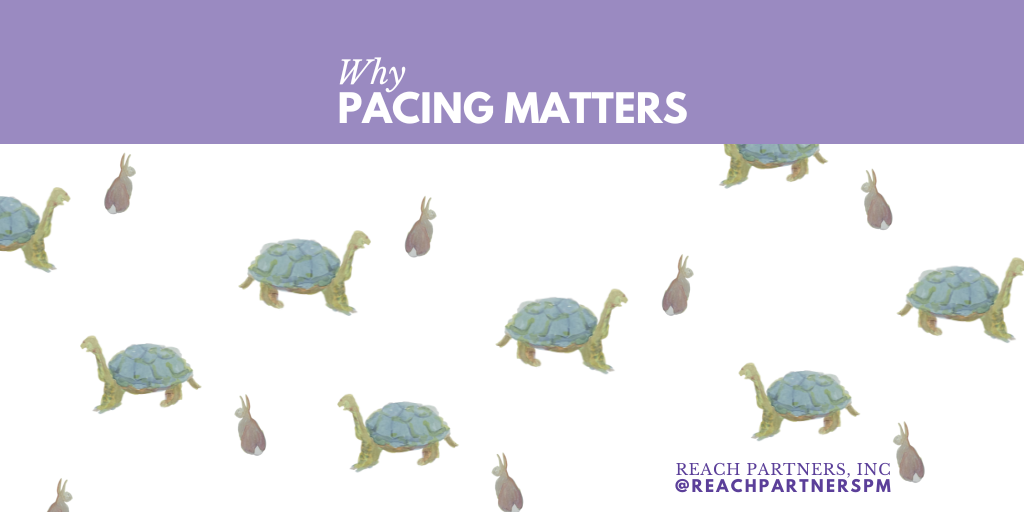|
When a team invites Reach Partners to join them, we’re asked to provide focus on a project. Even if the team members work side-by-side each day, they often need help with the pace of the project – the way a project’s progress moves forward. Different than a timeline or milestones, pacing is about understanding when to pause or slow down and when to speed ahead. Every milestone in a project’s plan deserves its own sense of pace. We recently met with one of our clients and she mentioned that her team had begun brainstorming for an upcoming project. She then added that she was looking forward to Reach Partners re-joining the team to lead this process.
It became clear as we talked that she wanted someone to set a pace for the meeting and project. Brainstorming and ideation are essential, yet groups can't stay in that place. Talking needs to move to action and pacing is essential to building an effective project team and momentum. When we work with teams, we do not allow them to slip back into ideation (a source of scope creep and fuzzy bunnies). We also keep an eye on the vision of the project. Don’t get us wrong. Brainstorming ideas is terrific, but we can’t get stuck there. As a team solidifies a plan, we often schedule a pause in the process so that we all have time to make sure that the ideas brought forward match the vision. For example, if a team is planning an event designed to be affordable, expensive ideas that force a higher ticket price are set aside. Pacing is one of the main attributes of facilitation. Reach Partners plans the conversation or work so that we can cover everything that needs discussion or direction in the time allotted. We recognize when to slow the pace so that everyone can engage. We know when to pause to demonstrate meaning or get buy-in. Here’s how that works: We once had a client that was excited to get things moving. They quickly polled a group of volunteers to find a time to meet. However, Reach Partners asked the client to first consider the purpose of gathering the volunteers. We encouraged and convinced the client to pause and push back the meeting for several months. Sometimes projects need to pause to move forward. Had the meeting mentioned above happened too soon, the true purpose and outcomes of the project would likely have not been met. Even the gathering of groups needs to be purposefully paced, as well as planned. Proper pacing supports a project’s momentum and prevents people from rehashing details. Once, one of our clients was discussing a key decision during a project planning meeting. Before moving forward, we told everyone that this was the time to express concerns; otherwise, the decision would be made and that particular detail wouldn’t be revisited. Pacing mitigates project anxiety, stress, and tension. Tasks and assignments focus forward on the outcomes and consecutive steps and milestones needed for a project. When Reach Partners comes to the table, it is time for action. Among other things, that means it is time to establish a pace for subsequent decisions and actions according to the time, people and budgetary resources available. Good pacing gives everyone the space and time they need to move forward effectively. – Anita
2 Comments
Phil
9/24/2022 09:12:43 am
You guys truly embody this, if organizing is a super power, REACH has this in loads.
Reply
Anita Hoffarth
9/28/2022 11:27:22 am
Thanks, Phil!
Reply
Your comment will be posted after it is approved.
Leave a Reply. |
Reach PartnersYour partners in leadership. Categories
All
Archives
July 2024
|
|
|
Reach Partners, Inc
3330 Fiechtner Dr. Suite 100 Fargo, ND 58103-2321 701-271-8170 Copyright (C) 2024 Reach Partners Inc.
|

